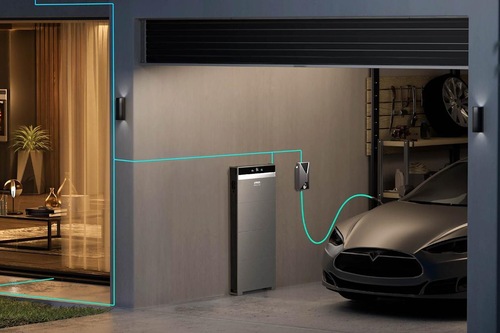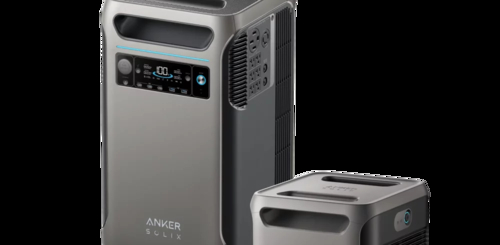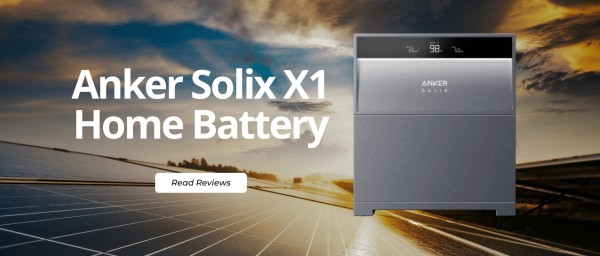Anker has been around since 2011, and you probably know them best for their reliable phone chargers and power banks.
They’ve freshly made a chief move: getting into home power storage. They launched the Anker Solix brand in 2023 and brought their residential energy solutions to Australia in late 2024.
The Anker Solix X1 is emerging as a great choice for Australian homeowners looking for a reliable solar battery. It combines impressive efficiency with a tough, weather-ready design built to handle Australia’s hot climate and salty coastal air. The system also includes a user-friendly app that makes monitoring and managing your home’s energy simple.
That said, the Solix X1 is still a relatively new player in the Australian market. Its long-term performance and the local installer network are still growing. At present, it’s limited to single-phase systems and doesn’t yet have confirmed support for Virtual Power Plant (VPP) programs, something worth keeping in mind if you plan to join one in the future.

Why does this matter? Anker’s new solar panel battery banks connect straight with your solar panels to give you an all-inclusive, green power setup. By using tough LiFePO4 batteries and their long-life InfiniPower™ technology, Anker Solix is taking multifaceted solar power and making it amazingly manageable and modest for environmentally minded homeowners.
Anker Solix Review for Australian Residents
If you’re considering a home battery in Australia, the Anker SOLIX X1 (henceforth “the SOLIX X1”) is certainly one of the more interesting decisions. Below is a thorough review covering strengths, weaknesses, value proposition, and whether it might be right for a residential installation.
What stands out (the strengths)
Here are some of the main advantages of the Anker SOLIX X1 for residential applications in Australia:
- Safe & modern battery chemistry
The system uses Lithium Iron Phosphate (LiFePO₄, often “LFP”) battery cells. These are broadly regarded as among the safest lithium-battery chemistries (less prone to thermal runaway than older lithium-ion/NMC types). For Australian homes, where heat, weather, and durability are key considerations, this is a significant advantage. - Modular & Scalable Design
You can start with a small capacity and scale up. For example, the AC-coupled version allows you to stack modules (in 5 kWh increments) up to ~30 kWh in one stack.
The hybrid models have even higher expandability (e.g., up to ~180 kWh in parallel systems) for larger homes or forthcoming growth.
This means you don’t essentially commit to a huge system today if your usage is moderate. - Good Fit for the Australian Environment
The Anker SOLIX X1 has features that make it more robust in harsh conditions: IP66 rating (for dust/water resistance), C5-M anti-corrosion coating (for coastal installations) and an operating range from around –20 °C to +55 °C in some variants. That means it’s more probable to endure hot summers, humid coastal air or outdoor installations. - Useful backup/blackout capability
The system proposes a fast switchover (less than ~10 milliseconds) from grid to battery in many models. For households concerned about outages, that’s a meaningful benefit. - Competitive pricing & value
According to current Australian pricing guides (2025), the SOLIX X1 is positioned with an attractive cost per kWh compared with many high-end competitors.
For example: ~AU$9,500–11,000 installed for ~10 kWh, ~AU$13,000–14,500 for ~15 kWh. (Note : Check the price with your vendor.)
What to watch (the weaknesses)
No product is flawless. Here are some of the limits or areas where the SOLIX X1 may fall short (or at least require careful planning).
- Brand/newer presence in the home battery market
While the parent company (Anker) is well known in electronics, in the Australian home-battery space, the Anker SOLIX brand is moderately new. Roughly, reviewers note this as giving slight hesitation around long-term support, installer breadth and “field-proven” history.
If you’re risk-averse and prefer a battery with decades of local deployments, this is something to consider. - AC-coupled vs hybrid limitations
The AC-coupled version is prodigious for retrofits (installing alongside existing inverter + solar panels), but it may not support solar charging during a blackout (unless you select the hybrid version). Some reviews point out that only the hybrid DC-coupled variant supports charging from solar while the grid is down. So, if blackout resilience is vital (and you already have solar), pay attention to which variant you choose. - Output power per module is somewhat modest for large loads
Some reviews note that the output (continuous AC power) per unit/module is limited (e.g., ~6 kW for one module in the AC-coupled version), so for very high-demand homes (large air-conditioning, EV charging, pool pumps), you may essential multiple modules or stacks.
If you’re expecting “whole house, high load” backup, sizing and system design become decisive. - Warranty / expected degradation slightly below top tier
While the warranty is 10 years (standard for the industry) and capacity retention is good, some independent reviews propose that the projected remaining capacity after 10 years might be a bit lower than the very top-performing systems. That may be substance if you are chiefly concerned about very long-term performance.
Suitability of Anker Solix X1 for Residential Installation in Australia

Given the strengths and weaknesses, here’s how I’d assess the Anker SOLIX X1 for a distinctive Australian home scenario:
- Best-fit scenario:
You already have (or plan to install) solar panels, need to decrease your grid consumption (self-consumption), perhaps have time-of-use tariffs or rising night-rates, and/or you want blackout backup capability. You want a battery that you can expand later.
You live in a single-phase (normal suburban) installation (not big commercial), and you may be in a climate with high heat/corrosion risk (coastal area, for example). The Anker SOLIX X1 fits this scenario very well. - Less ideal:
If you require supreme “whole-house, heavy-load” backup (e.g., full house plus EV charger plus pool + workshop all at once), you may find you are required to buy a larger system (more modules) or contemplate a system with higher continuous power per module.
Also, if you want the lengthiest possible brand track record or you reside in a location with very long grid-outage risk (and expect to go off-grid for extended durations), then you may evaluate competitor systems too.
Cost, Payback & Value Considerations
- Recent price guides show ~AU$9,500-11,000 for a ~10 kWh system (installed) and ~AU$13,000-14,500 for ~15 kWh.
- Value per kWh is competitive (~AU$900-1000/kWh) compared with many high-end alternatives.
- Payback/return depends heavily on your solar generation, household usage pattern (evening loads, time-of-use tariffs, self‐consumption vs grid feed‐in), and future electricity price rises.
- If blackout protection is a key driver (rather than pure financial payback), then the value equation changes: you may be buying peace of mind as much as cost savings.
Here’s a comparison of three home-battery systems available (or prepping to be available) in Australia, the Anker SOLIX X1, the Tesla Powerwall 2, and the sonnen Batterie series; showing how they stack up for residential use. We’ll briefly summarise the key specs, strengths/weaknesses, and suitability for an Australian home context.
Comparison Table with other Brands
| Metric | Anker SOLIX X1 | Tesla Powerwall 2 | sonnen Batterie (hybrid/Evo) |
| Usable Capacity / Modularity | 5 kWh per battery module; system scalable from ~5 kWh up to ~180 kWh (depending on variant) | Usable ~13.5 kWh (Total ~14 kWh) | Example: hybrid model up to ~15 kWh; modular design. |
| Continuous Power Output | For X1 hybrid single-phase: 3.68 kW to 6 kW (depending on power module) | 5 kW continuous (charge & discharge) | Example: sonnen Evo: backup power ~5 kW continuous, 7 kW surge. |
| Efficiency / Chemistry | Uses LFP (Lithium Iron Phosphate) cells; round-trip efficiency up to ~90.2% for some variants. | Approx ~90% round-trip efficiency. | Also LFP/iron-phosphate chemistry; efficiency quoted as high (e.g., 98% for one model) |
| Operating Conditions / Build | X1: very strong environmental specs: operable from -20°C to +55°C; IP66 dust/water resistance; C5-M anti-corrosion coating for coastal use. | Operating temp -20°C to +50°C; IP67 for battery part. | sonnen: designed for indoor/outdoor; IP56 rating for outdoor variant. |
| Warranty | 10 years (on typical model) | 10 years warranty; guarantees certain remaining capacity (70% at end of term) | 10 years or 10,000 cycles in many models. |
| Proven-ness / Market Presence in Australia | Relatively new entrant in the Australian home battery market. Some reviewers flag that installer familiarity and service network are still maturing. | Very strong brand recognition and many installations; widely supplied. | Good reputation in Europe, solid builds; somewhat less common in Australia than Tesla but established in market. |
If you’re after a home battery that’s modular, safe, and built for the future without breaking the bank, the Anker SOLIX X1 is well worth considering. It delivers impressive flexibility, reliable LiFePO₄ safety, blackout protection, and works seamlessly with both new and existing solar systems.
While Anker may still be a newer name in Australia’s solar battery market, it’s quickly earning trust. With Clean Energy Council approval, strong local support, and performance that rivals some of the industry’s biggest brands, the SOLIX X1 is a system we confidently recommend to the right homeowners.
At Solar Miner, we proudly install the Anker SOLIX X1 across New South Wales. Our team ensures your battery is perfectly sized for your energy needs, installed to the highest Australian standards, and supported by our experts every step of the way, from setup to long after your system is running smoothly.
Anker Solix X1 Battery Systems
The Anker Solix X1 comes in two main versions, a DC (hybrid) model and an AC-coupled model, giving homeowners the flexibility to choose what best suits their solar setup.

The AC-coupled models, approved by the Clean Energy Council, range from the X1-P6K-B05-S (X1-P6K-B05-AU) up to the X1-P6K-B30-S (X1-P6K-B30-AU).
These offer capacities from 5 kWh to 30 kWh, depending on whether you use one to six battery modules. A single Solix X1 stack can hold up to four modules, while further stacks can expand the system to a determined of six modules per power module. A basic 5 kWh system provides around 3 kW of output, while larger models deliver 6 kW or more.
For those wanting even superior capacity, the all-in-one hybrid (DC) single-phase system supports up to three parallel setups, delivering a total of 90 kWh of storage and 18 kW of power. A three-phase hybrid version was designed for large homes or small businesses, which will offer up to 180 kWh and 72 kW, and is expected to launch in late 2025.
All Solix X1 battery modules use Lithium Iron Phosphate (LiFePO₄) chemistry, known for its outstanding safety, stability, and long lifespan compared to other lithium-ion types. These systems are also built tough for Australian conditions, featuring IP65 (AC-coupled) or IP66 (hybrid) weather protection ratings, permitting for outdoor installation.
They operate consistently between -20 °C and +55 °C, and with their C5-M corrosion resistance, they’re perfect for coastal areas.
In the event of a blackout, the X1 switches to backup power in under 10 milliseconds, keeping your essential appliances running smoothly. In off-grid mode, it carries up to 6.6 kW (for single-phase systems) or 12.6 kW (for three-phase hybrids), providing at least three battery modules are installed.
It’s worth noting that only the hybrid models can recharge via solar panels during a blackout, an important advantage for energy independence.
The Solix X1 also features six smart energy modes; three designed for power management and another three for optimizing energy efficiency. A thoughtful touch is its illuminated display, which lights up when you approach the power module. Combined with the intuitive Anker Solix mobile app, homeowners can effortlessly monitor, manage, and control their entire energy system from anywhere.
Key takeaways / what this means for you in Australia
- Scalability & capacity: Anker’s SOLIX X1 stands out for its modular scalability, you can start small (~5–15 kWh) and scale up (to tens of kWh), which is great if you anticipate growing your solar, EV charging, etc. Tesla’s Powerwall is more of a fixed-capacity unit (~13.5 kWh), though you can install multiple. Sonnen offers a modular but it may require more upfront cost or planning to scale large.
- Environmental / harsh-conditions resilience: If you live in a coastal area or in a site with high salt-air corrosion or extreme heat (common in parts of Australia), Anker’s emphasis on anti-corrosion (C5-M) and high temp tolerance (to ~55 °C) is a plus. Tesla and sonnen are robust, too, but Anker Solix perhaps has a slight edge on the “harsh Aussie environment” build for its marketed specs.
- Brand, support & ecosystem: Tesla has a very strong brand and installer network in Australia, which may make service, parts and resale easier. Anker is newer, which means you might get a decent deal or newer features, but you may face somewhat more uncertainty around the installer ecosystem, local service & support. Sonnen sits somewhere in between, good build quality, less ubiquitous perhaps.
- Backup / whole-house readiness: If your main goal is backup during blackouts for large loads (air-conditioning, EV charger, pool pump, etc), then power output matters.
Tesla’s 5 kW continuous means you can run a fair chunk of a typical home; Anker’s X1 offers up to 6 kW+ in some variants, which is competitive. But if you have a very big house with 3-phase or high loads, you’ll need to carefully size. Sonnen’s backup output is sensible, but you’ll want to check for high-load sizing. - Cost & value: While we don’t have direct recent pricing for all models here in Australia, usually the newer entrants with strong specs (like Anker Solix) may offer improved cost-performance. But cost is highly dependent on installation, inverter compatibility, solar system size, location, and rebates/subsidies.
Also consider “future use” like EV charging, tariff arbitrage, and virtual power-plant (VPP) participation. For instance, some reviews of Anker note that its VPP/third-party participation status is still emerging in Australia. - Tariffs & compatibility: One reviewer flagged for Anker that “currently only allows battery discharge if you configure dynamic electricity pricing … I can’t configure my tariff so payback changed” (for UK but worth considering)
- For Australia you should check your local tariff (time-of-use, export/feed-in, etc.) and whether the battery system supports integration with your tariff structure, grid export rules, etc.
Which one suits which scenario?
- If you live in a moderately sized home, have solar already or plan to, use a lot of evening consumption, maybe live in a coastal or warm environment, and need scalable capacity and a “robust build” for Aussie conditions, we’d lean towards Anker SOLIX X1 as a strong choice.
- If you want effortlessness, proven track record, lots of installer options, brand recognition, and a solid mid-capacity battery (~13.5 kWh) is fine for your home, then Tesla Powerwall 2 is a safe bet.
- If you prioritise premium build, high competence, modular flexibility, and perhaps are interested in participating in progressive grid/virtual-power-plant scenarios (Sonnen has a good ecosystem), then consider Sonnen Batterie.
In Conclusion :
Overall, the Anker SOLIX X1 is a very good option for many Australian homes, combining modern battery chemistry, robust build for Aussie conditions, modular flexibility and competitive pricing.
If you match the installation to your desires (size it correctly, ensure you pick the right variant/hybrid vs AC, work with an experienced installer), then you should end up with a reliable home battery system.
Would I say it’s the best for every home? No, no battery is. But for many homes, it offers excellent value and features. If we were endorsing to a friend, yes, definitely consider the Anker SOLIX X1 as a top contender, but also benchmark against a few other battery systems (particularly if you have very high loads or very specific backup/EV/whole-house needs).
